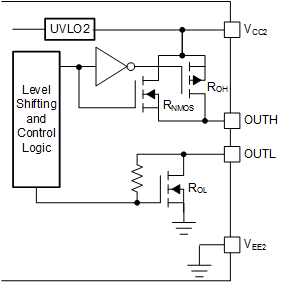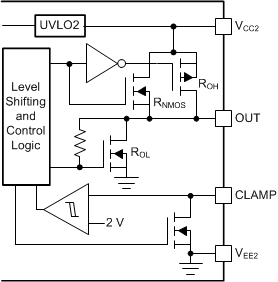JAJSN98E May 2020 – February 2024 UCC5350-Q1
PRODUCTION DATA
- 1
- 1 特長
- 2 アプリケーション
- 3 概要
- 4 概要 (続き)
- 5 Pin Configuration and Function
-
6 Specifications
- 6.1 Absolute Maximum Ratings
- 6.2 ESD Ratings
- 6.3 Recommended Operating Conditions
- 6.4 Thermal Information
- 6.5 Power Ratings
- 6.6 Insulation Specifications for D Package
- 6.7 Insulation Specifications for DWV Package
- 6.8 Safety-Related Certifications For D Package
- 6.9 Safety-Related Certifications For DWV Package
- 6.10 Safety Limiting Values
- 6.11 Electrical Characteristics
- 6.12 Switching Characteristics
- 6.13 Insulation Characteristics Curves
- 6.14 Typical Characteristics
- 7 Parameter Measurement Information
- 8 Detailed Description
- 9 Application and Implementation
- 10Power Supply Recommendations
- 11Layout
- 12Device and Documentation Support
- 13Revision History
- 14Mechanical, Packaging, and Orderable Information
パッケージ・オプション
メカニカル・データ(パッケージ|ピン)
サーマルパッド・メカニカル・データ
発注情報
8.3.3 Output Stage
The output stage of the UCC5350-Q1 features a pull-up structure that delivers the highest peak-source current when it is most needed which is during the Miller plateau region of the power-switch turn-on transition (when the power-switch drain or collector voltage experiences dV/dt). The output stage pull-up structure features a P-channel MOSFET and an additional pull-up N-channel MOSFET in parallel. The function of the N-channel MOSFET is to provide a brief boost in the peak-sourcing current, which enables fast turn-on. Fast turn-on is accomplished by briefly turning on the N-channel MOSFET during a narrow instant when the output is changing states from low to high. Table 8-1 lists the typical internal resistance values of the pull-up and pull-down structure.
| DEVICE OPTION | RNMOS | ROH | ROL | RCLAMP | UNIT |
|---|---|---|---|---|---|
| UCC5350MC-Q1 | 1.54 | 12 | 0.26 | 0.26 | Ω |
| UCC5350SB-Q1 | 1.54 | 12 | 0.26 | Not applicable | Ω |
The ROH parameter is a DC measurement and is representative of the on-resistance of the P-channel device only. This parameter is only for the P-channel device, because the pull-up N-channel device is held in the OFF state in DC condition and is turned on only for a brief instant when the output is changing states from low to high. Therefore, the effective resistance of the UCC5350-Q1 pull-up stage during this brief turn-on phase is much lower than what is represented by the ROH parameter, which yields a faster turn-on. The turn-on-phase output resistance is the parallel combination ROH || RNMOS.
The pull-down structure in the UCC5350-Q1 is simply composed of an N-channel MOSFET. The output of the UCC5350-Q1 is capable of delivering, or sinking, 5-A peak current pulses. The output voltage swing between VCC2 and VEE2 provides rail-to-rail operation because of the MOS-out stage which delivers very low dropout.
 Figure 8-5 Output Stage—S Version
Figure 8-5 Output Stage—S Version Figure 8-6 Output Stage—M Version
Figure 8-6 Output Stage—M Version